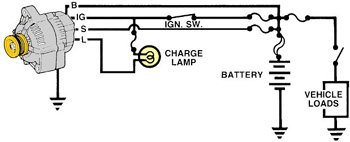Charlie_Iliff
Veteran Member
- Joined
- Jun 13, 2001
- Messages
- 1,890
- Location
- Arnold, MD
- Tractor
- Power Trac PT1845, John Deere 2240, John Deere 950, John Deere 755, Jacobsen Turf Cat II
I finally got around to a "permanent" fix for my alternator. After I got the bad diodes fixed, on advice of the repair shop I wired it only as a one-wire alternator. It worked two or three times, just revving it until the regulator kicked it in and the voltage went to 14+. Then, it stopped doing that. I could get it to charge fine by touching a 12V lead to the pole that was originally wired by PT with continuous 12V from the accessories circuit. Since my guru opined that straight 12V would fry the diodes if left on without the engine running, I wired in a momentary contact button, with a neon panel light across it. The post on the alternator is the idiot light post, so I could have made it automatic with a low resistance panel light between the positive and the alternator. I couldn't find such a panel light with a quick look, and the pushbutton and neon were easily available.
So, now I start the machine and the panel light turns on. I press the button and the light goes out and the voltage meter goes to 14+. Gives me a great feeling of satisfaction whenever I do it.
But I will never know for sure how the stick in the fan caused the fried alternator, or even if it did. Nor will I know for sure if there is anything at all wrong with putting 12V constantly to that post as PT did it originally. I do not plan any controlled tests to see if I can cost myself an alternator.
So, now I start the machine and the panel light turns on. I press the button and the light goes out and the voltage meter goes to 14+. Gives me a great feeling of satisfaction whenever I do it.
But I will never know for sure how the stick in the fan caused the fried alternator, or even if it did. Nor will I know for sure if there is anything at all wrong with putting 12V constantly to that post as PT did it originally. I do not plan any controlled tests to see if I can cost myself an alternator.

